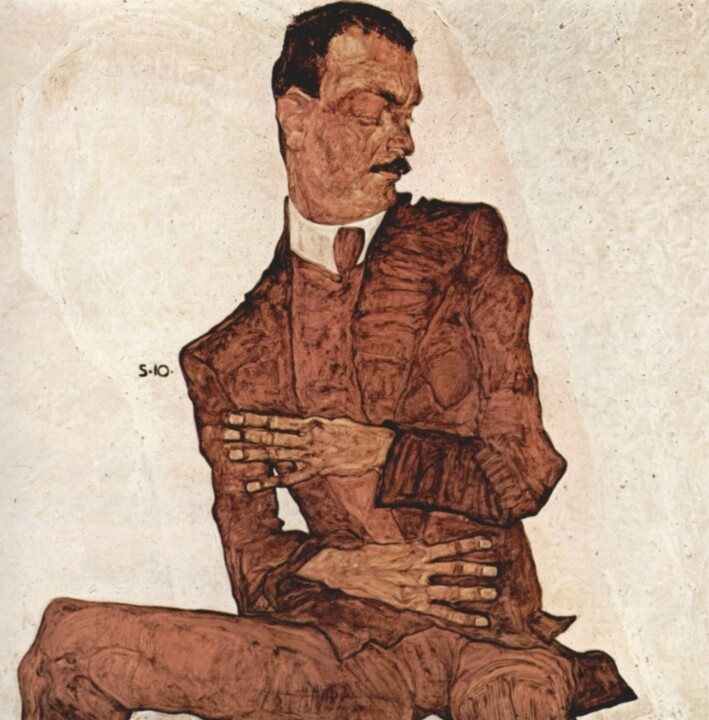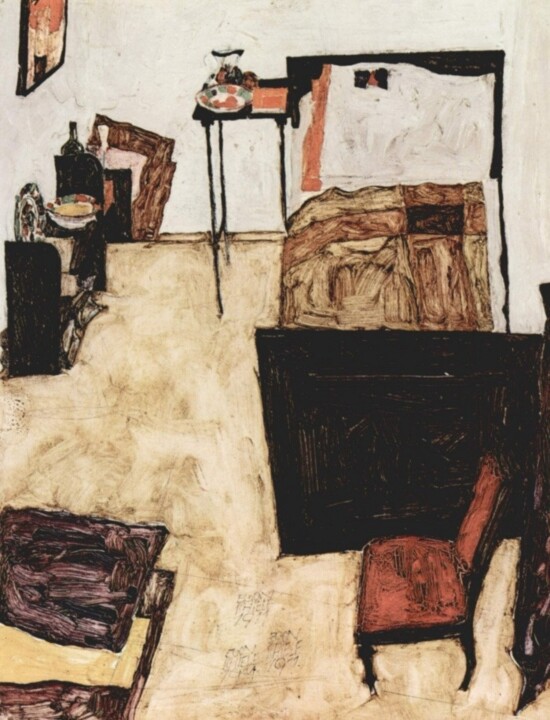 Egon Schiele, 1914. Photograph by Anton Josef Trcka (Antios)
Egon Schiele, 1914. Photograph by Anton Josef Trcka (Antios)
Who was Egon Schiele?
Egon Schiele was born June 12, 1890, in Tulln, Austria. In 1906, after finishing his education at Krems and Klosterneuburg, he enrolled at the Vienna-based Akademie der Bildenden Künste. He studied drawing and painting here, but found the school's rigidity discouraging. He met Gustav Klimt in 1907, who inspired him and had an impact on his work. In 1909, Schiele and other disgruntled students created the Neukunstgruppe after leaving the Akademie. Schiele participated in the 1909 Vienna Kunstschau at Klimt's request and saw the artwork of Edvard Munch, Jan Toorop, Vincent van Gogh, and other artists there. Schiele first met Arthur Roessler, an art critic and writer, at the first Neukunstgruppe exhibition in 1909 at the Piska Salon in Vienna. Roessler became a friend of Schiele's and praised his art in his writing. He started a close relationship with the collector Heinrich Benesch in 1910. Schiele was now receiving several portrait assignments from the Viennese intellectuals and had established a personal expressionist portrait and landscape style.
Schiele, who wanted isolation, left Vienna in 1911 and settled in a small village. He focused more and more on self-portraits, allegories of life, death, and sex, and created sexual watercolors. He was detained for "immorality" and "seduction" in 1912; throughout his 24-day prison, he produced a series of moving watercolors and drawings. Schiele took part in a number of group exhibitions, such as the Neukunstgruppe exhibitions in Prague in 1910 and Budapest in 1912, the Sonderbund exhibition in Cologne in 1912, and multiple Secession exhibitions in Munich starting in 1911. Schiele's first solo exhibition was presented in 1913 at the Galerie Hans Goltz in Munich. In 1914, he held a solo exhibition of his paintings in Paris. Schiele married Edith Harms the next year and was enlisted in the Austrian military. During his time in the military, he continued to display his work and painted frequently. He achieved critical recognition and commercial success in 1918 with his solo performance at the Vienna Secession. He passed away from influenza several months later in Vienna at the age of 28 on October 31, 1918, three days after his wife.
Egon Schiele, the master of explicit nudity
Schiele's portrayal of the naked person was revolutionary for its day and continues to astound people today. Even the most forward-thinking of Schiele's contemporaries found his work to be challenging. He twisted his subjects into sexualized, primal beings in an unrepentant, brazen, and exposing manner. It was claimed that during a sitting, Schiele painted freely and kept an almost continual eye on his subject, developing a close bond with her.
In 1910, Schiele started experimenting with nudes, and within a year he had developed a distinctive style that included slender, sickly-colored figures that frequently had overt sexual overtones. Schiele started to paint and sketch children as well. Kneeling Nude with Raised Hands (1910), a self-portrait by Schiele, is regarded as one of the most important examples of nude art produced in the 20th century. Schiele's innovative and daring approach to the naked human form confounded both academics and progressives. With its twisted lines and overt use of figurative expression, this unique piece and style defied rigid academic tradition and sparked a sexual commotion.
 Egon Schiele -The orange was the only light, 1912. Gouache, watercolor and pencil on paper, 31.9 × 48cm.
Egon Schiele -The orange was the only light, 1912. Gouache, watercolor and pencil on paper, 31.9 × 48cm.
The nude human body is intimate and private, typically only seen by a small number of people. Schiele constantly depicts his naked physique on canvas for public exposure despite the fact that it is often reserved for private moments. By doing so, he simultaneously subverts accepted norms and notions of decency and draws the audience into his intimate, personal world. He is exhibiting his true self, literally baring all. Schiele appears to be engaging in the highest form of self-expression after fighting for the freedom to make his art and defying social norms.
Because it is culturally expected that we keep the human body covered, protected, and out of public view, images of nudity have come to represent exposure, weakness, and vulnerability. Schiele rejects this assumption by taking a rebellious, open position in his self portraits; instead, he comes across as content with the exposure and eager to be seen for generations to come as his genuine self. Schiele's nakedness strips him of the conventional barriers to ego and self-expression, yet his image still comes off as incredibly expressive, forceful, and defiant. For Schiele, being naked is socially inappropriate, rebellious, and contentious—yet it represents the truth, the most authentic version of oneself, free of any pretense and artifice. In a society where Schiele was frequently an outcast, he chooses to portray himself as naked, deformed, and unapologetic. Egon Schiele - Portrait of Edith Schiele with Striped Dress, Sitting, 1915. Pencil and gouache on paper, 40.2 x 50.8 cm. Leopold Museum, Vienna
Egon Schiele - Portrait of Edith Schiele with Striped Dress, Sitting, 1915. Pencil and gouache on paper, 40.2 x 50.8 cm. Leopold Museum, Vienna
Schiele’s style and accomplishments
Schiele was an incredibly productive artist, producing almost three thousand drawings during the course of his brief career. His major artistic medium was drawing, which he valued for its spontaneity of expression and used to create some of the best drawings of the 20th century. Even in his painting, where he placed a strong emphasis on contour, graphic mark, and linearity, there were traces of a distinctive drawing-inspired aesthetic.
With their unprecedented level of emotional and sexual directness and use of figural distortion in place of conventional ideals of beauty, Schiele's portraits and self-portraits contributed to the revival of both genres. Schiele's portraits, which commonly feature himself or people close to him, frequently feature their subjects in the nude, placed in disturbing angles, frequently seen from above, and devoid of any secondary characteristics typical of the portrait genre. Schiele occasionally included conventional themes, giving the very intimate pictures a more general, metaphorical message on the status of humanity.

Egon Schiele - Portrait of Arthur Rössler, 1910. Oil on canvas, 99.6 × 99.8 cm. Leopold Museum, Vienna.
Schiele's development was mostly influenced by the painter Gustav Klimt, who was both his friend and mentor. Although Schiele adopted Klimt's emphasis on erotic depictions of the female form (and shared Klimt's insatiable sexual appetite), the emotionally intense, frequently unsettling Expressionist style Schiele eventually developed, with its investigation of his sitters' inner lives and emotional states, in some ways directly opposed his mentor's Art Nouveau-inspired style.
Schiele's art has drawn criticism for being grotesque, erotic, pornographic, or frightening, with a focus on sex, death, and discovery, from critics like Jane Kallir. Schiele is seen as having flexible sexuality and gender, according to Kallir and researcher Gerald Izenberg. According to Kallir, Schiele was struggling with his own sexual inclinations and gender conventions at a time when gender norms were changing, the early women's movement was gaining ground, and homosexuality was being criminalized. In the twenty-first century, several reviewers interpreted his work as queer.
 Egon Schiele - My living room (The artist's room in ), 1911. Oil on wood, 40 x 31.5 cm. Kunsthistorisches Museum, Vienna, Austria
Egon Schiele - My living room (The artist's room in ), 1911. Oil on wood, 40 x 31.5 cm. Kunsthistorisches Museum, Vienna, Austria
The legacy
Despite having a brief life, Egon Schiele created an incredible amount of works on canvas and paper. He had a key role in shaping the characteristics of early 20th-century expressionism, which were the use of wavy lines, a frequently somber color scheme, and frequently dark symbolism. Schiele made a large number of self-portraits, demonstrating an obsession with the self on par with Picasso-like levels. This is in contrast to his mentor Klimt, with whom Schiele's name is most frequently connected. Both Expressionist contemporaries like Oskar Kokoschka and Neo-Expressionist successors as diverse as Francis Bacon, Julian Schnabel, and Jean-Michel Basquiat were significantly affected by Schiele's style. Egon Schiele - Der Maler Max Oppenheimer, 1910. Black chalk, India ink and watercolor on paper, 45.1 x 29.8 cm. Albertina Museum, Vienna, Austria
Egon Schiele - Der Maler Max Oppenheimer, 1910. Black chalk, India ink and watercolor on paper, 45.1 x 29.8 cm. Albertina Museum, Vienna, Austria
Schiele's life and work were the subject of Herbert Vesely's 1980 biographical film Excess and Punishment, Joanna Scott's 1990 novel Arrogance, as well as essays, including one on portraiture in which fashion photographer Richard Avedon discussed Schiele's work. In his 1997 novel The Notebooks of Don Rigoberto, Mario Vargas Llosa seduces and ethically takes advantage of the main character by using Schiele's artwork as a conduit. Schiele's self-portraits served as inspiration for Rich Pellegrino's painting in Wes Anderson's The Grand Budapest Hotel, David Bowie's 1979 album Lodger's cover art, and An Honest Deceit by Guy Mankowski, published in 2017.
 Egon Schiele - Portrait of the painter Anton Peschka, 1909. Oil and metallic paint on canvas, 110.2 x 100 cm.
Egon Schiele - Portrait of the painter Anton Peschka, 1909. Oil and metallic paint on canvas, 110.2 x 100 cm.
Egon Schiele's most famous paintings:
- Portrait of Gerti Schiele, 1909; Museum of Modern Art, New York; Purchase and partial gift of the Lauder family, 1982, and private collection
- Portrait of Wally, 1912; Leopold Museum, Vienna
- Self-Portrait with Chinese Lantern Plant, 1912; Leopold Museum, Vienna
- Hermits, 1912; Leopold Museum, Vienna
- Houses with Laundry (Seeburg), 1914
- Death and the Maiden, 1914-15; Österreichische Galerie Belvedere, Vienna
- Portrait of Edith Schiele the artist's wife, 1915; Kunstmuseum Den Haag, Netherlands
- The Embrace, 1917; Belvedere Palace and Museum, Vienna
- Four Trees, 1917; Belvedere in Vienna, Austria
- Town among Greenery (The Old City III), 1917; Neue Galerie New York. In memory of Otto and Marguerite Manley, given as a bequest from the Estate of Marguerite Manley
- Reclining Woman, 1917; Leopold Museum, Vienna
- Kneeling Girl Resting on Both Elbows, 1917; Leopold Museum, Vienna
Art collections
The Leopold Museum, which houses more than 200 of them, is home to what is arguably Schiele's most significant and comprehensive body of work. One of these, Houses With Colorful Laundry (Suburb II), was sold by the museum in 2011 for $40.1 million at Sotheby's. The Austrian Galerie Belvedere, the Albertina Graphic Collection, and the Egon Schiele-Museum, all of which are located in Vienna, are other noteworthy collections of Schiele's artwork. Schiele's works, notably Dämmernde Stadt, were gathered by Viktor Fogarassy. Other museums that hold Schiele's works include the Metropolitan Museum of Art, the Museum of Modern Art, and the National Gallery of Art.
 Egon Schiele - Leopold Museum, 2008, photography by: Alan Islas
Egon Schiele - Leopold Museum, 2008, photography by: Alan Islas


 Selena Mattei
Selena Mattei












